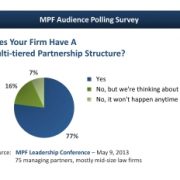On May 9th, we presented The MPF 2013 Leadership Conference in Atlanta. During the Conference’s opening session, we employed audience polling technology to ask the audience of more than 75 managing partners – mostly from mid-size law firms – a series of questions important to leading a successful law firm.
One of the questions we asked was:
“Does Your Firm Have A Multi-Tiered Partnership Structure?”
The responses indicate a clear trend. 77% of the managing partners polled reported that their firms have implemented a multi-tiered structure, with another 16% considering it. Only 7% of respondents plan to stick with the traditional single-tier partnership model.
Here’s the complete breakdown:

These responses clearly reveal that mid-size law firms are following the lead AmLaw 200 firms set back in the mid-90s in adopting multi-tier partnership structures.
Before 1990, the vast majority of the largest US law firms operated as single-tiered partnerships. Young lawyers either achieved partner status – or were forced to leave the firm after seven to eight years as an associate. But in the mid-nineties, a momentous shift took place. AmLaw 200 firms began adopting a two-tiered structure, and by 2007 80% of them had adopted such a structure.
Mid-size firms lagged, however. Many were hesitant to change a structure that had been in place for decades, and were wary of creating a class of partners that might be viewed as “second-class citizens.”
However, this data indicates that mid-size firms have “seen the light” in recent years and have joined the largest law firms in adopting a multi-tiered partnership structure.
The MPF Perspective
We think multi-tiered partnership structures make sense for most mid-size firms for many compelling reasons. Most fundamentally, multi-tiered structures allow firms to retain attorneys who are talented technicians, but simply don’t want to put in the time and effort required to become an owner of the firm.
Research conducted by the National Association of Law Placement (NALP) and the National Association of Women Lawyers (NAWL) tells us that there are many younger (and older) lawyers who are content to work 40-hour weeks, make handsome livings, and never achieve equity partner status. “Gen X” and “Gen Y” lawyers are often more concerned with work-life balance than their predecessors. Women have made up more than 50% of law firm graduates for decades now, yet only 13% of equity partners are women in AmLaw 200 firms. The fact remains that many women (and men) lawyers desire to spend less time working and more time with family.
Multi-tiered partnership structures allow firms to retain these lawyers by granting them non-equity partner status. This practical solution that allows the lawyer to gain the prestige that comes with the title of “partner” – while absolving the firm of the need to distribute equity partnership to lawyers who don’t have an “ownership” mentality.
However, if you do go in this direction, you must be very clear in defining what “non-equity” status means, and how it will be used.
Some firms use non-equity partnership as a temporary holding place for young lawyers rising through the ranks on the way to equity partnership. Others use it as a sort of “purgatory” for lateral transfers, an opportunity to ensure that the “fit” is right before granting equity partnership. Some use it as a place for senior partners who are no longer pulling their weight. And still others view it as a permanent position for lawyers that are content not to attain ownership.
To avoid confusion and conflict in the future, it’s critical that you define the criteria for all partnership tracks – and specify how each track will be utilized. In addition, clearly define voting rights, responsibilities, and the level of information that each “tier” of partner will be able to access.
We’re pleased to see indicators that mid-size law firms are adapting multi-tiered partnership structures. We believe that these structures will serve the interests of these firms well. As long as firms take care to carefully define their partnership structure, a two-tiered structure is a win-win scenario both for individual lawyers and for their firms.
###

About the Author
John Remsen, Jr. is President and CEO of The Managing Partner Forum, the country’s premiere resource for managing partners and law firm leaders. He is also President of TheRemsenGroup, one of the country’s leading consulting firms for mid-size law firms. John was recently admitted as a fellow in the College of Law Practice Management and can be reached at 404.885.9100 or JRemsen@ManagingPartnerForum.org.












 404.885.9100
404.885.9100 404.885.9111
404.885.9111 info@managingpartnerforum.org
info@managingpartnerforum.org The Managing Partner Forum Atlanta, Georgia
The Managing Partner Forum Atlanta, Georgia